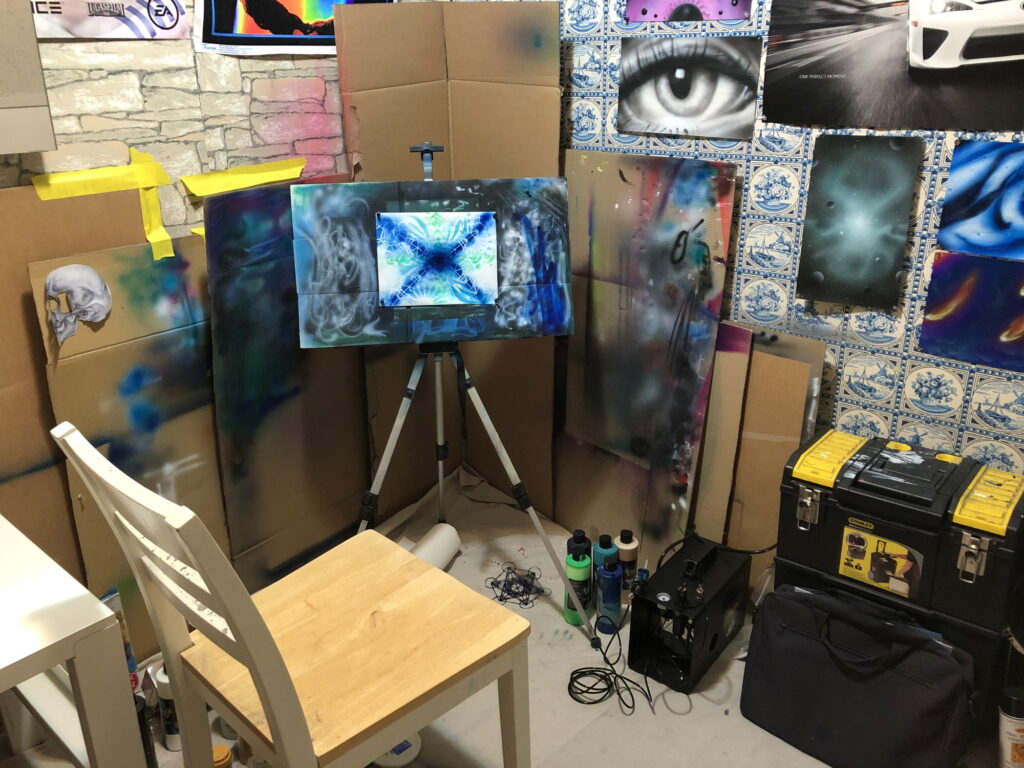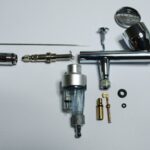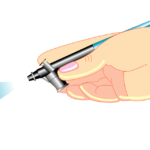Great airbrush equipment is an essential part of any functioning airbrush setup. This is because airbrushing has slightly more moving parts than other art forms such as handheld brushwork.
Airbrushing has 3 main components:
- the air compressor
- the hose, and
- the airbrush.
For learn about components #1 and #3, checkout this in-depth review on airbrush air compressors, and this article about choosing the right kind of airbrush. Jump ahead to the airbrush hose section of this article to learn more about component #2.
A functioning airbrush setup only needs these three components to function. However, there are many side components that can take your airbrushing setup to the next level.
What airbrush equipment you should get is heavily dependent on your intended usage. Sometimes you don’t have to upgrade to better equipment unless you need it. This article will systematically run through each piece of equipment, the intended usage, and make recommendations on which airbrush equipment you should get.

Table of Contents
- Airbrush Hose
- Airbrush Holder
- Airbrush Cleaning Pot
- Wash Bucket
- Easel
- Drop Cloth
- Stencils
- Air Filter/Moisture Trap
Airbrush Hose
Best All Around Airbrush for Automotive Paint
The two most common types of airbrush hoses are plastic and braided. The plastic ones usually come with airbrush kits and do the trick for most airbrushing applications. If you are just painting at home, aren’t moving your setup around too much, and are fairly gentle, then a plastic one will work just fine.
If you are transporting your airbrush setup, working on dynamic projects that involve lots of movement, or working in rough and dirty environments, you definitely want to get the braided airbrush hose for added durability.
Airbrush Holder
Best All Around Airbrush for Automotive Paint
You don’t need anything fancy for an airbrush holder. When I first started out, I would just hang my airbrush on the side of my wash bucket. The important thing is that your airbrush isn’t lying down on its side. If you’re using a gravity-fed airbrush, the paint will run out of the hopper and spill all over the place.
Some compressors like the Iwata Power Jet Pro have built-in airbrush holders, but if yours doesn’t have one, it would be worth getting something like this to attach to the side of your workspace.
Airbrush Cleaning Pot
The cleaning pot doubles as a cleaner and an airbrush holder. It works by collecting all the overspray from cleaning solution or water that is sprayed through the airbrush. A pressure release filter lets the excess pressure out without splashing paint and solvent all over the room. The cleaning pot is ideal for minimizing overspray and keeping your workspace pristine.
Bonus: A great cleaning solution for airbrush paints is Iwata-Medea’s airbrush cleaner. It does a great job of dissolving all kinds of paint without being too harsh on your airbrush equipment.
Wash Bucket

A wash bucket is another great alternative for washing your airbrush. For a more hectic work environment, sometimes a dainty airbrush cleaning pot is simply not fast or thorough enough for a deep clean. A wash bucket allows you to dunk your whole airbrush into a water and cleaner solution, spray some solution through the nozzle, wipe the hopper out with a rag, and keep on painting.
I have found through years of body painting in bars and clubs that this method gets a deep clean done quickly and effectively. Something sturdy that won’t tip over easily like an ice cream pail works perfectly.
Airbrushing Easel
Your choice of airbrush easel depends entirely on your intended usage and work style. First, consider how large your canvases/substrates will be. Obviously, if you intend to paint large canvases, get something that’s large enough to accommodate your projects.
The second consideration is whether to get a standalone easel or a counter-top easel. Take a look at your workspace to determine where you will setup the easel – do you have a high counter-top or a low counter-top? Do you want to work primarily standing or sitting? Maybe you intend to work standing and sitting?
There are some great counter-top easels that can stand-up or fold down for working flat. Keep in mind that you will probably be doing most of your airbrushing in the “stand-up” position. But the necessity for a flat workspace does arise and it is much easier to simply fold your easel down than to reposition your canvas/substrate onto another flat workspace.
Standalone easels are perfect for wide open workspaces without a work counter. I recommend just getting one with extendable legs. This gives you maximum versatility to set-up your canvas at any sitting or standing height
Airbrush Drop Cloth
A drop cloth is meant to protect the floor/ground from spilled paint. I highly recommend getting a canvas drop cloth rather than a plastic one. Canvas is sturdier, it lasts longer, and it soaks up small paint spills so you don’t have to worry about smearing paint around with your feet.
Drop cloths come in various sizes. If you plan on setting up your airbrush equipment in a permanent workspace, measure out the area and try to get a drop cloth that fits your work area. It’s alright if it doesn’t fit perfectly, just fold it into the right dimensions. Duct tape the sides to the floor and you’re good to go.
Drop cloths are also very transportable. If you’re moving workspaces frequently, just get a large drop cloth so you’re ready for any environment.
Airbrush Stencils
If you’re doing a lot of stencil work, stencil accumulation can quickly run out of control. Checkout this other article for information on how to build a unique stencil collection.
Start organizing your stencils and taking very good care of them from the very beginning. As your collection grows, it will be essential to have a good system in place so you don’t lose or damage your stencils.
I’ve found over the years that a large briefcase with flat compartments works great for storing stencils and keeping them in pristine condition.
Airbrush Air Filter/Moisture Trap
Airbrush air filters help keep your air supply clean and dry. They act as a last defense to trap excess moisture and tiny particulates from entering your airbrush. Some air compressors come with built-in air filter/moisture traps, but you can also get an in-line option.
My personal opinion on air filter/moisture traps is that they are kind of unnecessary. Unless you are doing some extremely fine detail work, an air filter/moisture trap is not going to dramatically change your results. I’ve worked in extremely dusty and humid conditions without any issue. However, if you want to deliver the most undoubtedly dry and clean air as possible to your airbrush, it doesn’t hurt to install an air filter/moisture trap for that added confidence in your setup.
There you have it, the top airbrush equipment that you need to get the most out of your airbrushing setup. A great airbrushing setup should make you feel prepared and comfortable in any job or any environment – and most important of all, it should make airbrushing fun.
Happy painting!









